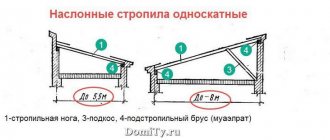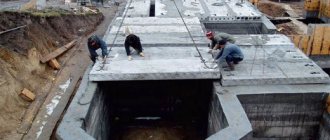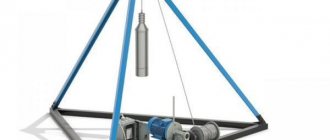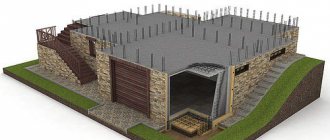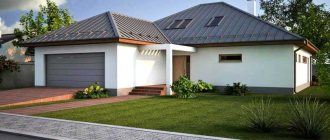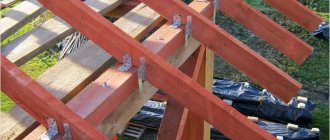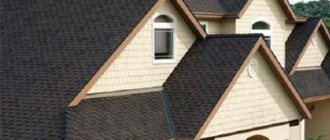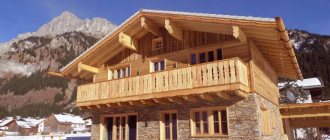Today, houses with a bay window are considered very fashionable, but when building them, difficulties arise in the process of decorating the roof over them. The roof structure should be in harmony with the design of the overall structure and the structure of the main roof, complementing and improving the style. Depending on the shape of the bay window, different types of roofs are used, but the hip roof is considered the most common.
Bay window: origin and advantages
A bay window is usually called a part of a room that extends beyond the plane of the facade. The prototype of the bay window became a popular architectural detail in the early Middle Ages; placed high on the fortress wall, it provided all-round visibility and a convenient firing angle. The fashion for houses with projections has continued to this day; bay windows have changed and become a popular architectural solution in private housing construction.
The shape and size of the bay window depends on the construction project. In appearance, the bay window resembles a covered balcony; By design, it is part of a room with solid walls. It can occupy one or several floors, be wall-mounted or corner; the base is a trapezoid, semicircle, rectangle or polyhedron. A bay window extension provides the following advantages:
- Additional space with interesting design possibilities.
- Improved access of natural light to the room; The extension most often has glazing along the entire perimeter, often with panoramic windows.
- The original appearance of the house.
On the outskirts of London Source thewalls.ru
The disadvantages of this architectural element include the following facts:
- Increased cost of design and construction work.
- Increased heat loss . There are limitations to the complete insulation of a room, since not all methods of insulation and heating are suitable. The problem is partially solved by using energy-saving (multi-layer) double-glazed windows.
The device of the narozhniki
In the lower part, the frames are the same rafters, they have a completely similar method of attachment to the Mauerlat , the same installation step. They are mounted strictly at right angles to the base , the upper part to the corner rafter leg.
Fastening is carried out with at least two nails or other elements . The upper part of the splice is cut at the desired angle to the horizon and to the diagonal rafters to ensure a tighter connection and guarantee resistance to loads.
Bay roofs and methods of their construction
The roof over the bay window can take one of the following forms:
- Multi-pincer. Structurally the most complex form .
- Decorative . Decorated with various elements - turrets and spiers.
- Hemisphere (dome).
- Hip . The form preferred by most owners of country houses. The hip design is the most economical option in terms of capital investment and labor costs.
House made of corrugated timber with a bay window Source iobogrev.ru
Bay window roofing can be done in two ways:
- Associated with the main roofing structure, more complex in calculations.
- Independent . In this case, the rafters of the decorative roof do not bear large loads, so timber with a smaller cross-section is used to install the rafter system. For finishing, the same material is used as for the main roof.
The method of covering a bay window with a gable roof spread in the 17th century and existed (in mass construction) until the beginning of the 20th century. In modern projects, a gable roof with a bay window is not often found, although this method has some advantages over a hip roof. A hip (multi-gable) bay roof requires highly qualified carpenters, since in this case it is assumed that rafter beams will be used, and the structure requires careful adjustment.
Associated bay roof Source s-stroit.ru
See also: Catalog of companies that specialize in roof design and repair.
Bay window hip: features and varieties
The classic hip roof is formed by four pitched planes converging at an angle to two peaks connected by a ridge. A pair of main slopes has the shape of a trapezoid, a pair of side slopes have the shape of a triangle.
A hip roof with a bay window undoubtedly decorates the house and allows the use of original interior solutions; At the same time, adding a bay window to the project complicates the design; it becomes multi-sloped. The slopes, intersecting, form an internal corner, the most vulnerable place in which precipitation tends to accumulate. The corner connection is called a valley, and a roof with a similar architectural element is called a valley roof. Its main disadvantage is the complexity of construction. During design, the requirements for the quality of calculations increase; minor errors can lead to reduced reliability and deformation of the roof. At the same time, the hip roof boasts the following advantages:
- Attractive appearance and the possibility of expanding the living space - attic.
Endova - the junction of the slopes Source board.infox.by
- Durability and resistance to wind and rain loads. The smaller the slope of the slopes, the more streamlined the shape becomes and the less load falls on the rafter frame.
- Large overhangs look organic on such a roof , providing protection for the façade walls from rain moisture.
- Due to the absence of gables, the load of the roofing system on the walls and foundation of the housing is distributed evenly .
In addition to the classic one, there are other types of hips, each with its own characteristics of the rafter structure and possibilities for arranging a bay window:
- Tent . The slopes converge at one point and form a multifaceted pyramid. The ridge is missing; instead, a more difficult to implement ridge knot is formed. The hip roof is used for small bay windows, which take on the appearance of decorative turrets attached to the house. It looks the most organic.
Tent structure Source yandex.ru
- Broken (attic) hip . The most difficult design to implement, in which the slopes at a certain height change the angle of inclination (to a smaller one); the number of individual planes doubles from four to eight. The broken hip provides maximum under-roof space and is well suited for arranging a bay window that protrudes significantly beyond the plane of the facade.
- Half-hip . On the side (triangular) slope there is a vertical pediment in which it is convenient to install a window. Gable (Dutch, with a shortened triangular slope and pediment) and hipped (Danish, pediment ends with an end slope) half-hip roofs are common. Depending on the device, the half-hip can be combined with a bay window.
Half hip Source viksar.ru
Diagonal rafter legs
The elements of the rafter system that form the ribs connecting the planes of the slopes are called diagonal (oblique, corner) rafter legs.
Strictly speaking, diagonal and slanted elements are not entirely identical , since the first are attached to the outside of the corners of the mauerlat, and the second - from the inside.
Otherwise, all properties are the same.
Corner elements have certain features:
- The length of the diagonal rafter legs significantly exceeds the length of the straight rafters.
- Diagonal rafter legs serve as support for the frames on both sides of the connecting planes.
The presence of such features creates an increased—about one and a half times—load on slanted rafters compared to conventional ones. Their length exceeds the usual length of the boards from which the rafters are made, therefore, to make slabs, the boards are welded together - they are connected along the plane in two layers.
This solves several problems at once:
- You can make beams of any desired length.
- Increases resistance to loads.
- Ability to use one modular material size.
Under the diagonal rafter it is necessary to install one or two supports (depending on the length), and the point where the support is located is not in the middle, as it would seem at first glance, but at a distance of one third to a quarter of the entire length of the slanted rafter, counting from the top point, since it is in this area there is a place of greatest stress .
Sloping rafters located in the valleys have the opposite location of the point of maximum effort - approximately one third to a quarter of the length from below.
Diagonal rafter legs
Yandovaya (bay window) roof: preparatory work
The manufacture of the bay window frame and the construction of the roof begins after the design work has been completed and the roofing material has been selected. Design work begins with determining the following parameters:
- Selecting the roof angle by region . It is set taking into account local climatic conditions: the minimum angle (2-5°) is selected for dry places with strong winds. In regions with long and snowy winters, the roof angle is increased.
- Selecting the roof angle based on the material . The selected roofing material also influences the angle of inclination. For each type of coating there is an optimal laying angle. For example, for metal tiles it is 14°, for corrugated sheets - 12°, for slate - 22°. Membrane roofing can be laid at any angle.
- Determination of proportions . Based on the slope, the length of the rafters is determined.
Supports for diagonal rafters
Either struts or vertical posts made of timber or paired boards can be used as support for diagonal rafters. The stand can rest directly on the ceiling , through a layer of waterproofing and a wooden lining.
This requires sufficient rigidity and strength of the floor. If such conditions do not exist, then a strut is used, resting on the beam and supporting the slanted rafter at a given point.
The angle of inclination of the strut does not play a role in this case , the main thing is the connection point, i.e. Load concentration location. For a rafter length of up to 7.5 m, a brace from the top point of maximum load is sufficient, but for a length of more than 9 m, an additional support is required at the bottom.
This can be either support on the ceiling, if it allows, or support on the truss - the so-called. truss truss - a stand reinforced with struts on the sides.
Supports for diagonal rafters
Video description
About designing a roof with a bay window in the following video:
- To ensure that the house does not resemble a birdhouse after completion of construction, the appearance of the future roof is assessed at the design stage, using three-dimensional modeling .
- Determining the pitch of the rafters . It is affected by the weight of the finishing coating; the gap between the rafters can vary in the range of 0.6-1 m.
- Definition of sheathing device , which is determined by the roof covering. Calculation of the size and number of sheathing elements.
- Calculation of building materials . It is carried out based on the area and slope of the roof. Any details are taken into account: dormer windows and chimneys will require an increase in the budget.
Diagram of a bay window with a gable roof Source domax-fahverk.ru
Preparation for construction: materials
In order to eliminate annoying downtime in roofing work, even before the construction of a hipped roof with a bay window begins, they stock up on the necessary materials, which include:
- Lumber . Board and timber; care must be taken to pre-treat them to protect them from moisture.
- Hardware . Self-tapping screws, screws, roofing nails, studs.
- Tie wire and galvanized plates for additional fastening.
- Materials for roofing pie , including waterproofing membrane. The choice of a two-layer waterproofing film eliminates the need for a ventilation gap; in this case, the insulation layer and the membrane are placed closely.
- Roof covering.
Bay window under a soft roof Source yandex.kz
Yandovaya (bay window) roof: installation
Installation is carried out in accordance with the developed roof design with a bay window; the rafter system of this design consists of the main roof rafter system and the bay window rafter system. The design determines whether the systems will be separate or whether they will need to be connected to form connecting points. Installation of roofs of different designs follows the same algorithm (the difference lies in the number and shape of the rafters) in the following sequence:
- Markings are made on the top trim: axes, projections and the location of the main elements are outlined. The rafter system is installed .
- . It is convenient to assemble individual rafters on the ground. The finished rafters (in the shape of a triangle) are lifted to the assembly site, where they are interconnected into a single structure and attached to the beams located at the base. The parts are fastened with self-tapping screws and, additionally, with plates made of galvanized metal.
How to choose the type of rafter system for a 4-pitched roof?
In the absence of a central roof support, the choice is made in favor of a hanging rafter system. If you can find upper and lower supports for each rafter, then you should choose a layered structure. This option is simpler and more accessible for non-professional craftsmen. You just need to remember two main conditions: when rigidly fastening the bottom and top of the stops, a reinforced Mauerlat is needed, since the thrust is transferred to it; with a hinged fastening or a semi-rigid connection (for example, the top is hinged and the bottom is rigid or vice versa), the Mauerlat does not need to be reinforced:
Video description
About the bay window rafter system in the following video:
- The sheathing is being filled . If a flexible material is chosen for the roof, the sheathing is made solid. If the material is hard (corrugated sheet or metal tile), sparse (cellular) sheathing is installed.
- A roofing pie is formed . It consists of sequentially fixed layers of film vapor barrier, insulation and waterproofing.
- The counter-lattice is attached . It holds the roofing pie and is a system of wooden slats that are laid across the rafters.
- The lower valley strips are installed . They are placed at the joints of negative angles and connect the bay window and the main roof. The valley is additionally protected from sagging by installing a continuous sheathing (regardless of the chosen finishing coating).
- The finishing coating is being laid . After the roof is completely laid, the upper valley strips are installed. They perform a decorative role, covering the joints of the slopes.
Corner bay window Source pxhere.com
Construction of a four-slope rafter system
The four-slope rafter structure consists of the following elements: mauerlat, ridge beam, central and hip rafters, slanted legs, as well as beds, racks, crossbars, struts and other reinforcing parts. Let's look at the most basic elements.
I. Mauerlat
The Mauerlat is the most important part of the structure, since the entire rafter system rests on it. It is a powerful wooden beam 100x200, 100x250, 100x100, 150x250, 200x200 cm. The mauerlat is made from solid high-quality wood, mainly coniferous. The rafter system of a hip roof, like any multi-pitched roof, requires thorough fastening of the base beam. The procedure for installing the Mauerlat in this case: the formation of a monolithic foundation at the end of the load-bearing walls with the installation of spiers; laying waterproofing; processing and installation of Mauerlat around the perimeter of the entire house; reinforced with anchors and other fastenings for maximum reliability of the base.

